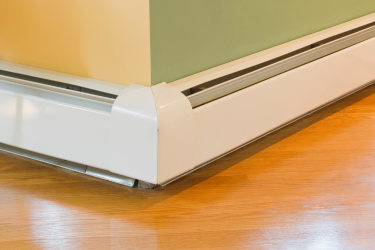
Written by Kayla Jane Barrie Updated on Feb 21, 2025 5 mins read

As winter approaches and temperatures drop, many homeowners turn to baseboard heaters as a reliable source of warmth.
According to Statistics Canada, in 2021, 51% of Canadian households reported having a forced air furnace as their primary heating system, while 25% reported having electric baseboard heaters.
In this blog post, we will explore the world of baseboard heaters, how they work, insurance considerations, and associated costs.
Electric baseboard heaters are a type of heating system that is commonly installed along the baseboards of walls. These heaters comprise a heating element enclosed in a metal housing designed to radiate heat into a room.
They are easy to install and operate and are popular for providing additional heat or as the primary heat source in smaller spaces. The heating element is powered by electricity and generates heat radiating into the room.
Baseboard heaters are an excellent choice if you want additional warmth without making complicated changes to your home's forced-air heating system. These heaters can be permanently hardwired or used as portable units plugged into outlets.
They are recognized for working silently and do not require any ductwork. Baseboard heaters are the way to go if you have an older home and need a simple heating solution.
Baseboard heaters operate on the principle of convection heating. They contain a metal heating element powered by an electric current. As the element heats up, the air surrounding it also warms up, causing it to rise and spread the heat evenly throughout the room.
The cold air is drawn in at the bottom, heated by the element, and then released back into the room. This convection process is efficient and effective, ensuring that the temperature in the room remains consistent and comfortable.The electric baseboard's heating element warms up as an electric current driven by electrical resistance. Unlike units with fans, baseboard heaters rely on natural heat dispersion throughout the room. Control is maintained through a thermostat on the unit or wall-mounted for accuracy.
Ensure proper clearances, with a 3/4-inch gap at the base for air circulation and 12 inches above for draperies to prevent fire hazards. Maintain a safe distance for furniture, considering both fire risk and airflow restriction.
Electronic and hydronic baseboard heaters represent distinct heating systems with unique characteristics. Electronic baseboard heaters, also known as electric ones, employ electricity to heat a metal element, providing quick convection heating directly.
In contrast, hydronic baseboard heaters use a liquid (commonly water or oil) to transfer heat through a closed-loop system, delivering consistent warmth over time. Electronic heaters are generally quicker to respond, but hydronic systems may offer greater energy efficiency in the long run.
Installation and maintenance differ, with electronic heaters being simpler and hydronic, requiring a closed-loop system. While electronic heaters often have lower upfront costs, hydronic systems may be more expensive initially but potentially yield lower operating costs over time.
The choice between them hinges on cost considerations, energy efficiency preferences, and heating performance priorities.
When installing or using baseboard heaters, it's important to consider insurance implications. While baseboard heaters are generally considered safe, following proper installation guidelines and ensuring that the units are well-maintained is essential.
Your home or tenant insurance provider will inquire about the age of your electric baseboard heaters. Models exceeding 50 years old may impact your Ontario home insurance eligibility due to their increased susceptibility to malfunctions and being an increased fire hazard.
The risk lies in the potential consequences of a malfunctioning heater, especially during winter, when a failure could result in frozen and burst water pipes. While home insurance typically covers burst pipes, reviewing your flood insurance details is essential if you have concerns.
Insurers will also be interested in your maintenance and replacement practices for baseboard heaters. Honesty is crucial in this regard, as a minor misrepresentation could be the determining factor between an approved or denied claim. Most policies will not cover damages from neglect or wear and tear. Even if you have tenant insurance, understand what your policy includes.
Some policies may have specific requirements or restrictions related to heating systems, so it's advisable to consult with your insurance provider to confirm that your coverage is not affected.
The cost of baseboard heaters can vary depending on the type of heater, the room's size, and the unit's energy efficiency. Depending on local rates for hydro, you could spend between $150-$500, or more, during winter to heat your home with electric baseboards.
Generally, baseboard heaters are more cost-effective than other heating options, mainly when used in smaller spaces or as a supplemental heating source, such as with a woodstove. Additionally, the ease of installation often reduces labour costs, making them an attractive choice for budget-conscious homeowners.
The operational expenses of baseboard heaters vary according to local utility rates. Here is an example:
Consider installing radiant floor heating or a gas-powered ductless heat pump, saving you more money.
Installing a baseboard heater involves two main steps: affixing the heater to the wall and configuring the electrical wiring. Mounting the heater is a simple task, while the electrical work typically requires the expertise of a licensed electrician. Local regulations may necessitate obtaining a permit before commencing the installation process. It is highly recommended to hire a professional to support the process of installing a baseboard heater.
Maintenance and cleaning are crucial for the optimal performance of baseboard heaters. Here are some key areas to keep tidy:
If the cause of the damage is covered by your condo insurance, then you can file a claim and get financial support for repairs or replacement. If you are experiencing issues from non-accidental damages and wear and tear, you will likely not be covered. Always check your policy and be sure you understand what is covered.
Electric baseboard heaters are 100% efficient in converting electricity to heat. However, operating costs can vary depending on the weather, the size of your home, and if you have any secondary heat sources, such as a fireplace.
Baseboard heaters are a popular, reliable, and energy-efficient heating solution for many Canadians. Homeowners can make informed decisions about their heating needs by understanding how these heaters work, considering the implications for home insurance, and estimating costs.
As technology advances, baseboard heaters are expected to remain a staple in Canadian households as a primary heat source, providing warmth and comfort for many years.
| Categories | Home |
|---|---|
| Tags | Protect Your HomeSeasonal HomeHome Maintenance |
Read our insurance blog to get helpful tips, information and news.
Has your car been totalled in an accident? Is your car a write off? Learn about vehicle write offs for a total loss insurance claim.
Get the facts on Toronto's auto theft problem. We break down the data, reveal the most-stolen vehicles (including the Honda CR-V and Lexus RX 350), and show which neighbourhoods are most affected.
Dive into the world of auto theft with our blog on the most stolen cars in Canada. See the most stolen cars across Canada, including provincial lists for Ontario and Quebec, and learn how high-risk models can affect your car insurance premiums.
Drive safe this winter! Check out these tips for driving in snowy and icy conditions in Ontario. Get other helpful info and FAQs on winter driving.